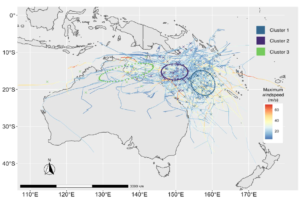Griffith University researchers have analysed 50 years of tropical cyclone tracks to better understand their behaviour in the hopes it could develop some level of prediction for future cyclones in light of our changing climate.
Researchers from Griffith’s Coastal and Marine Research Centre used data from the Bureau of Meteorology to investigate the characteristics and trends of tropical cyclones that originated in the Coral Sea off the Queensland coast from 1970-2020.
PhD Candidate John Miller said the historical study aimed to understand trends in the frequency, direction and curvature (how much the cyclone moved around) of these tropical cyclones within well-defined groups; and to examine location trends relating to maximum intensities within these three defined groups, or ‘clusters’.
- Cluster 1 was centred in the Coral Sea, it was the most south easterly located group and the TCs in this group often track predominantly south-east, occasionally making landfall. It is this cluster that is most likely to impact the South East Queensland coast due to its location and predominant tracking direction. TC Zelia (2011) is an example.
- Cluster 2 was centred in the Coral Sea closer to the coast than group 1, and the TCs in this group track predominantly laterally from east to west, occasionally making landfall. TC Yasi (2011) is an example.
- Cluster 3, although having TCs with genesis in the Coral Sea, was centred on the western edge of the Gulf of Carpentaria, with the TCs tracking predominantly overland in a west-south-west direction, usually making landfall. This cluster is interesting in that the cyclones often travel long distances overland over the northwest of Australia. TC Abigail (2001) is an example.

TC tracks with centroids clustered by first moment (track centroids).
“Cluster 3 is quite an interesting one, because it is a group of cyclones that travelled long distances in a westerly then south-west direction.”
“A previous study into why that could have been happening suggested that they regained energy from the moisture in the soil, over Northwest of Australia, and then they had that energy then to propagate long distances.”
The team found that all three Clusters had different characteristics not only in their direction but also their frequency and curvature, or movement pattern during their lifetime.
- Clusters 2 and 3 showed a high degree of lateral movement.
- Clusters 2 and 3 often tracked in a westerly direction and had their ellipse centres much closer to land;
- Cluster 3, the cluster of most westerly position, had the highest median of power dissipated per track but Cluster 2 has shown a marked increase in power and curvature since 2004.
“Although there was a statistically significant downward trend overall for frequency of tropical cyclones in the Coral Sea, this trend was only evident in one of the three Clusters: Cluster 1, and could be considered to have a reduced risk potential in future out of the three, however the tracks in this cluster are also the closest to the highly populated and growing SE Qld region,” Miller said.
“This research contributes to the knowledge of tropical cyclone behaviour in relation to sea surface temperature and climate phenomenon and helps to anticipate their future behaviour in the light of a changing climate.”
“It also provides insight to the analysis of tropical cyclone risk based on geo-location and cyclone track evolution that can be applied on a wide range of temporal and spatial scales.
“After this analysis, what we have is the behaviour analysis of the cyclones from the Coral Sea in the past 50 years, but we haven’t really got the detail on what’s driving this behaviour yet, which will be the next paper we publish.”
This research is part one of three planned by the team – the next will examine possible reasons behind their direction, track, intensity and the changes that could be impacting these; the final will look at the waves and swell generated by cyclones.
The findings ‘Divergence of tropical cyclone hazard based on wind-weighted track distributions in the Coral Sea, over 50 years’ have been published in Natural Hazards.


